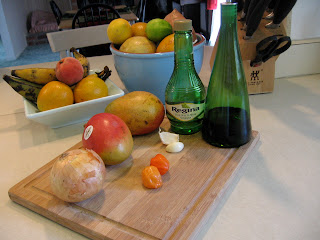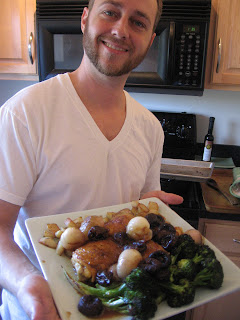I picked up a tip in Haiti about frying plantains that has made all the difference. And with the Tex-Carib policy of spending the equivalent of a month's salary in the afore-mentioned country on fancy-pants oil for frying, I think I now make plantains better than plain ol'
Carib, without the
Tex.
I'd attempted the nanner-lookin' fruit a few times in the past, but they were always hit or miss, heavy on the miss. And I can admit that now that I've cracked the code.
During our trip to see the boys the staff at the guest house cooked up plantains twice, but the first time I missed out. I was having some issues. You know. Third world issues.
Cara said the second batch wasn't nearly as good as the first. Of course. You should've been here an hour ago! I also missed the roasted goat, which I was really looking forward to trying.
But back to the task at hand- avoiding studying for boards.
Step One: Selection
I'm fairly certain that other than the fact that I pretty much just make up all this stuff as I go along, that the reason I had so little success with plantains in the past was the fact that I didn't know when to cook them. Figuring out when they are supposed to be ripe on the internet wasn't helping because there is no article on Wikipedia on the subject, and that's the only source I trust. I can now spare you that misery:

I bought four nice plantains a week ago and today was finally the day when it was time to get down to business. So what you see pictured here to even darker is the target ripeness zone. If you find yourself with a nearly black plantain, don't throw it away. Give it to me.
Plantains, when not ripe, are starchy fruit-taters, but they're not at all sweet. If you're making plantain chips like the one they serve at the local dive Crabby Joe's, then this is what you want. If, however, you're looking to make a sweet Tex
-Carib delight, wait it out. Because as they ripen they sweeten into something that would make Crabby Joe slap his momma.
Step Two: Cut the ends off.
I think that says it all, but here's a picture. Just in case.
 Step Two and a Half: Peel It.
Step Two and a Half: Peel It.You'll want to make long scores down the side and peel off the sides. I forgot to mention this when I started this post, and I don't feel like changing all the numbers.
 Step Three- Cut it Up
Step Three- Cut it Up
I prefer to cut things on the bias. That is to say, like this:

 Step Four: Fry, Part (A)
Step Four: Fry, Part (A)The tip I picked up is this:
like a well made fry, you've gotta double-fry plantains.

Just get 'em mostly golden. Like this:

Then let them cool off for a few minutes while you enjoy a beverage. Then smash them a little, like this:

Then fry them again (Fry, Part (B)), until they're golden brown and crispy on the outside, but creamy sweet on the inside. Make sure you hit them with a pinch o' kosher salt when they're fresh out of the oil. And speaking of oil, I used coconut oil. And not just any coconut oil, cause I've tried a few brands now, and what you're about to see is by far the best, cleanest tasting oil I've tried yet:

We're just about out of this stuff, and that makes me sad because it's so good I think one of the ingredients is "unicorn tears." We get it
from this place, which looks to be a home-school family that keeps to themselves in Northeastern Minnesota, and spends their time reading about alternatives to the normal American diet that won't kill you. I imagine they're fans of Ron Paul too. My kind of people! I could say a lot about coconut oil, but suffice it to say that it's a saturated fat that is good for you, unlike what you may have heard from the food police/government. Read up on the Wilderness Family's site if you're interested. Or read
this book if you're a true glutton for punishment. Yes, I read that book.
And yes, I realize that I quit numbering the steps it takes to make these things. I got tired of counting. You'll be okay.
Anyway, this is what you'll have at the end:

I'd suggest one plantain per person, cause I always make one for the both of us and end up coveting the wifey's share of the wealth. Oh yeah, they're right tasty with
mango habanero hot sauce, too.





























































